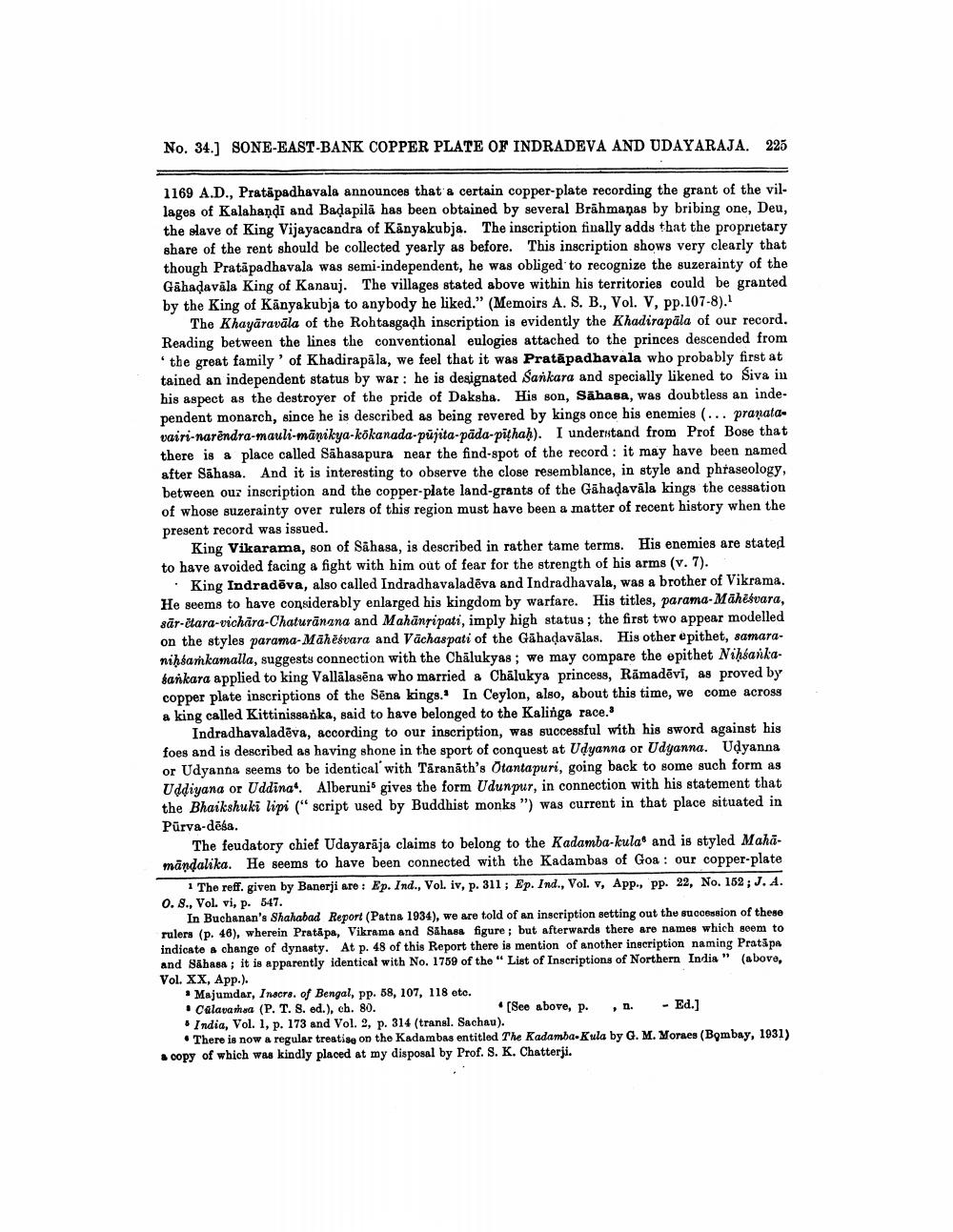________________
No. 34.) SONE-EAST-BANK COPPER PLATE OF INDRADEVA AND UDAYARAJA. 225
1169 A.D., Pratäpadhavala announces that a certain copper-plate recording the grant of the villages of Kalahandi and Badapilā has been obtained by several Brāhmaṇas by bribing one, Deu, the slave of King Vijayacandra of Kanyakubja. The inscription finally adds that the proprietary share of the rent should be collected yearly as before. This inscription shows very clearly that though Pratápadhavala was semi-independent, he was obliged to recognize the suzerainty of the Gābadavāla King of Kanauj. The villages stated above within his territories could be granted by the King of Kanyakubja to anybody he liked.” (Memoirs A. S. B., Vol. V, pp.107-8).
The Khayāravāla of the Rohtasgadh inscription is evidently the Khadirapala of our record. Reading between the lines the conventional eulogies attached to the princes descended from *the great family of Khadirapāla, we feel that it was Pratāpadhavala who probably first at tained an independent status by war: he is designated Sankara and specially likened to Siva in his aspect as the destroyer of the pride of Daksha. His son, Sāhasa, was doubtless an independent monarch, since he is described as being revered by kings once his enemies (... pranata. vairi-narendra-mauli-mānikya-kökanada-pujita-pāda-pathah). I understand from Prof Bose that there is a place called Sāhasapura near the find-spot of the record : it may have been named after Sāhasa. And it is interesting to observe the close resemblance, in style and phraseology, between ouz inscription and the copper-plate land-grants of the Gahadavāla kings the cessation of whose suzerainty over rulers of this region must have been a matter of recent history when the present record was issued.
King Vikarama, son of Sähasa, is described in rather tame terms. His enemies are stated to have avoided facing a fight with him out of fear for the strength of his arms (v.7).
• King Indradēva, also called Indradhavaladēva and Indradhavala, was a brother of Vikrama. He seems to have considerably enlarged his kingdom by warfare. His titles, parama-Māhëśvara, sār-étara-vichara-Chaturanana and Mahānripati, imply high status; the first two appear modelled on the styles parama-Mähèsvara and Vāchaspati of the Gahadavālas. His other epithet, samaranişšarkamalla, suggests connection with the Chalukyas ; we may compare the epithet NiharikaSankara applied to king Vallalasēna who married & Chalukya princess, Ramadēvi, as proved by copper plate inscriptions of the Sēna kings.' In Ceylon, also, about this time, we come across a king called Kittinissanka, said to have belonged to the Kalinga race.
Indradhavaladēva, according to our inscription, was successful with his sword against his foes and is described as having shone in the sport of conquest at Udyanna or Udyanna. Udyanna or Udyanna seems to be identical with Täranāth's Otantapuri, going back to some such form as Uddiyana or Uddina". Alberunis gives the form Udunpur, in connection with his statement that the Bhaikshuki lipi ("script used by Buddhist monks") was current in that place situated in Pūrva-dēša.
The feudatory chief Udayarāja claims to belong to the Kadamba-kulao and is styled Mahāmandalika. He seems to have been connected with the Kadambas of Goa : our copper-plate
1 The reff. given by Banerji are: Ep. Ind., Vol. iv, p. 311; Ep. Ind., Vol. v, App., PP. 22, No. 152; J. A. 0.8., Vol. vi, p. 547.
In Buchanan's Shahabad Report (Patna 1934), we are told of an inscription setting out the succession of these rulers (p. 48), wherein Pratápa, Vikrams and Sähase figure ; but afterwards there are names which seem to indicate a change of dynasty. At p. 48 of this Report there is mention of another inscription naming Pratápa and Sabasa ; it is apparently identical with No. 1759 of the "List of Inscriptions of Northern India" (above, Vol. XX, App.).
• Majumdar, Inscrs. of Bengal, pp. 58, 107, 118 etc. • Calavathua (P. T. 8. ed.), cb. 80.
[See above, p. n. -Ed.] • India, Vol. 1, p. 173 and Vol. 2, p. 314 (transl. Sachau).
• There is now a regular treatise on the Kadambas entitled The Kadamba-Kula by G. M. Moraes (Bombay, 1931) copy of which was kindly placed at my disposal by Prof. S. K. Chatterji.




